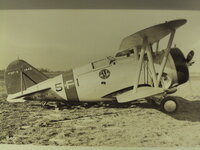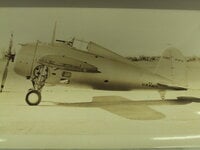Wild_Bill_Kelso
Senior Master Sergeant
- 3,231
- Mar 18, 2022
The Wildcat was a 'pretty good' naval fighter. Grumman had to walk the fine line between everything you need to operate from a carrier, including the fuel needed to fly long missions and stay up for CAP for hours at a time, vs the performance needed to contend with enemy fighters and shoot down enemy strike aircraft - as well as enough guns to do both jobs. All with a moderately powerful engine at best. It was a very difficult task.
The F4F-3 was a decent compromise. Just at the line of acceptability if slightly below it. It wasn't fast but a two-stage supercharger meant that it still had some pep at altitude, which was a saving grace.
But when they decided they needed folding wings, they made the F4F-4, which climbed like an overloaded truck, and had inferior speed. It allowed for 50% more aircraft on the carrier, which definitely helped, but the power of the (1200 hp, R-1830) engine was not increased while the weight certainly did increase, and the result was fairly dismal. The same can be said for many of the earlier Martlet types used by the British.
Eventually, though far too late IMO, they came out with the FM-2, with 1350 hp Wright 1820-56. My understanding is that this was made possibly due to technical improvements in cooling fins made during the development of the lager Pratt and Whitney R-2800. That extra 150 hp seemed to really improve performance, such a climb rate, but at the expense of losing the two stage supercharger.
The problem is that between the F4F-4 and the FM-2, there was about a year and a half where the USN (and to some extent the USMC and the RN) had to rely heavily on the F4F which was overloaded and underpowered. Meanwhile Japanese and German aircraft were improving. The Japanese got the improved A6M3 and Ki-43-II, as well as the Ki-61 and Ki-44. They also got the fast B6N torpedo bomber. The Germans got the scary Fw 190 and improved models of the Ju 88. F4F-4 is falling way behind these types in 1943.
I can see in the history of the Pratt and Whitney R-1830 double wasp that they did eventually make some variants with 1350 hp, starting with the R-1830-75, and then the R-1830-94. I assume these were either not ready, or too late. I know the focus for Grumann and the Navy was on the Hellcat, with good reason, and Chance- Vought was developing the very promising Corsair. But I think they needed a stop-gap. Could they have made a clipped wing, 4 gun, lighter Wildcat? Could they have gotten the R-1830-75 or 1830-94 working reliably a bit earlier with some more effort?
What I'd really like to do is make one which is a bit longer and less stout. But I realize that is probably impossible so I'll settle for clipped wings and 150 more horespower. It seems like that should be in reach.


Looking at the Wildcat, it seems like the designer just didn't want to taper the fuselage at all. I realize they had to accommodate the diameter of the engine, bud did it really need to be that wide all the way back?
The F4F-3 was a decent compromise. Just at the line of acceptability if slightly below it. It wasn't fast but a two-stage supercharger meant that it still had some pep at altitude, which was a saving grace.
But when they decided they needed folding wings, they made the F4F-4, which climbed like an overloaded truck, and had inferior speed. It allowed for 50% more aircraft on the carrier, which definitely helped, but the power of the (1200 hp, R-1830) engine was not increased while the weight certainly did increase, and the result was fairly dismal. The same can be said for many of the earlier Martlet types used by the British.
Eventually, though far too late IMO, they came out with the FM-2, with 1350 hp Wright 1820-56. My understanding is that this was made possibly due to technical improvements in cooling fins made during the development of the lager Pratt and Whitney R-2800. That extra 150 hp seemed to really improve performance, such a climb rate, but at the expense of losing the two stage supercharger.
The problem is that between the F4F-4 and the FM-2, there was about a year and a half where the USN (and to some extent the USMC and the RN) had to rely heavily on the F4F which was overloaded and underpowered. Meanwhile Japanese and German aircraft were improving. The Japanese got the improved A6M3 and Ki-43-II, as well as the Ki-61 and Ki-44. They also got the fast B6N torpedo bomber. The Germans got the scary Fw 190 and improved models of the Ju 88. F4F-4 is falling way behind these types in 1943.
I can see in the history of the Pratt and Whitney R-1830 double wasp that they did eventually make some variants with 1350 hp, starting with the R-1830-75, and then the R-1830-94. I assume these were either not ready, or too late. I know the focus for Grumann and the Navy was on the Hellcat, with good reason, and Chance- Vought was developing the very promising Corsair. But I think they needed a stop-gap. Could they have made a clipped wing, 4 gun, lighter Wildcat? Could they have gotten the R-1830-75 or 1830-94 working reliably a bit earlier with some more effort?
What I'd really like to do is make one which is a bit longer and less stout. But I realize that is probably impossible so I'll settle for clipped wings and 150 more horespower. It seems like that should be in reach.
Looking at the Wildcat, it seems like the designer just didn't want to taper the fuselage at all. I realize they had to accommodate the diameter of the engine, bud did it really need to be that wide all the way back?


